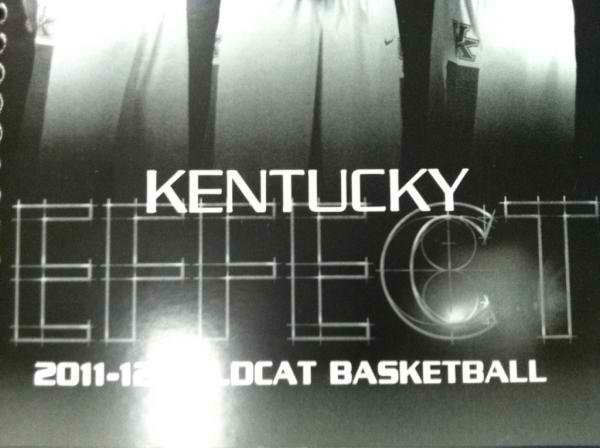The Kentucky Algebra: Solve For Eight
Posted by Gerald Smith on October 20th, 2011The massive amount of alumni, donors and fans of basketball science who support Kentucky care very much about mathematics. In particular, the accumulation of positive numbers.
Two years ago they celebrated being the first school to reach the number 2000 in basketball wins. A few days ago they cheered loudly as they unfurled the fourteenth colored banner allowed to decorate the huge research lab of Rupp Arena. The program also celebrated the three days worth of intense computation that resulted in an increment of Southeastern Conference Tournament titles. While elated with the progress, none of these are the specific answer desired by Kentucky Math fans. They want the ultimate answer: An eighth NCAA National Championship.
Kentucky’s researchers were making incredible breakthroughs in the 1990s. Dr. Rick Pitino used several years of research in Full Court Pressology to finally solve for six. Before he could apply the same formula to solve for seven he left for a professional position for a storied firm in Boston. Dr. Tubby Smith immediately used many of Dr. Pitino’s components but mixed them with Intense Defense Limits stretching from one to suffocating. The result: Seven. As time passed Kentucky supporter’s error tolerance level was reduced to near-zero and Dr. Smith took his research to Minnesota. Dr. Billy Gillispie‘s early theories were promising but his science unsound.
Now it falls to Dr. John Calipari to find the proper solution. He too is a controversial choice for the position of Director of Men’s Basketball Research. Some of his previous results at Massachusetts and Memphis failed peer-review by the National Collegiate Academy of Answers. (The NCAA is a notoriously fickle bunch; many methods used by football-based researchers were seemingly unfair but summarily passed.) Yet no one can deny that his reliance on young, inexperienced student researchers have yielded amazing results.
Under the scrutiny of twenty thousand armchair professors, Dr. Calipari’s newest team of field researchers were introduced last Friday evening during Big Blue Madness.
Big Blue Nation’s excitement for this year’s experiments started immediately after Dr. Cal’s 2010-11 trial ended. Once again Calipari recruited the best of the basketball’s researchers from high school. The big difference was the several members of the 2010-11 team of Wildcat number-producers elected to forsake professional research gigs. (Seemingly a good choice since many professional basketball researchers have been locked out of their labs due to wage negotiations.) Kentucky Math fans enjoyed all the preliminary events — including quite an entertaining presentation by Dr. Matthew Mitchell, the Kentucky women’s basketball Director of Research Studies, and cheered with measurable quantitative effect for many former student-athletes — before settling in to hear Dr. Calipari’s presentation.
As it is his wont, the presentation served two purposes. First Dr. Cal reassured the devotees of Kentucky Basketball that his research is making progress towards another National Championship result. Secondly he used his presentation to entice current top high-school basketball recruits to consider a tenure in Lexington. Both purposes were addressed in the label for this year’s formula: The Kentucky Effect. Even the most daft of amateur scientists who witnessed the presentation could see Kentucky’s and Cal’s message in the drafting font.

A photo of the 2011-12 UK Basketball Media Guide. Look closely within the letter C. Don't move until you see it.
As much as the audience enjoys the pomp and circumstance of reports, they would rather see data production and collection in action. They know the ultimate goal and had no qualms reminding Dr. Calipari: When he asked, “what’s next?” during his presentation, a significant portion of the audience responded with “eight!”
Dr. Calipari’s student-athletes put on their lab jerseys and gave the crowd a live experiment. First-of-the-season experiments like these typically use no defensive constants, so offensive results should be adjusted with a high tolerance level. Yet incredible scores were collected with ease from all points on the hardwood plane: Senior forward Darius Miller noticeably changed his shooting motion, hitting five-straight 3-pointers. Returning sophomore forward Terrence Jones used multiple vectors of intense magnitude to attack the rim. Heralded freshmen Michael Kidd-Gilchrist, Kyle Wiltjer and Anthony Davis contributed as though they’ve been producing at Kentucky for years.
Combining the results from the two exhibition teams, they scored — seven plus six equals thirteen, carry the one — 139 points. Kentucky’s supporters left Rupp Arena highly satisfied and optimistic. Expectations are higher than just contending for a National Championship. However Kentucky fanatic-based pressure values remain way below 1977-78 levels, when Dr. Joe B. Hall solved for five during “The Season Without Celebration“.
There’s no doubt Dr. Calipari and his team will apply defense-based subtraction of opponent’s scores slowly throughout the season. Other aspects of the winning formula remain a mystery: Will freshman point guard Marquis Teague become a stable support assistant for his teammates? Will Cal apply the correct researchers to the correct in-game tasks? How many 4s (power-forwards), 3s (shooting forward/wing forward) and 2s (shooting guards) will it take to baffle North Carolina‘s experienced crew of talented researchers? Will the Kentucky team handle pressure when competing in nationally-televised experiments in March?
All those associated with and that support the Kentucky Department of Basketball Mathematics know what answer they want. But factoring the winning formula, isolating the variables and limiting the variance of control by opponents will be season-long exercise. Better break out the dust-free chalk.










































